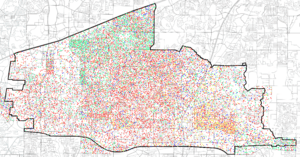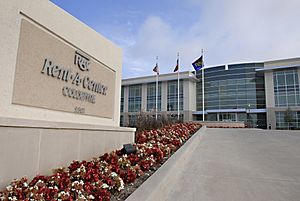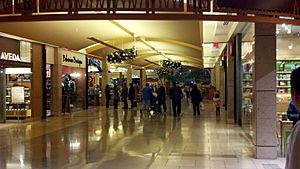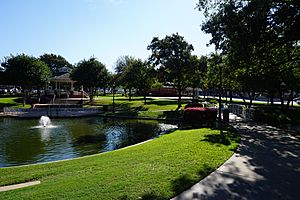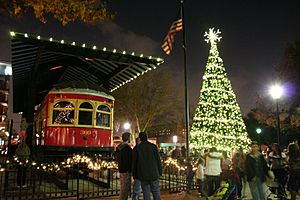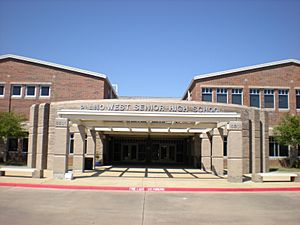Plano, Texas facts for kids
Quick facts for kids
Plano
|
|||
|---|---|---|---|
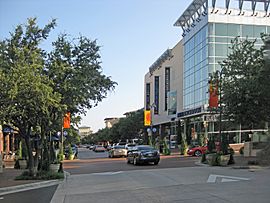
Legacy Town Center in Plano
|
|||
|
|||
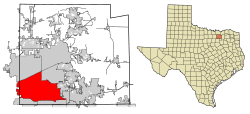
Location within Collin County
|
|||
| Country | United States | ||
| State | Texas | ||
| Counties | Collin, Denton | ||
| Incorporated | June 2, 1873 | ||
| Government | |||
| • Type | Council-Manager | ||
| Area | |||
| • Total | 72.04 sq mi (186.59 km2) | ||
| • Land | 71.69 sq mi (185.67 km2) | ||
| • Water | 0.36 sq mi (0.93 km2) | ||
| Elevation | 715 ft (218 m) | ||
| Population
(2020)
|
|||
| • Total | 285,494 | ||
| • Density | 4,012.96/sq mi (1,549.42/km2) | ||
| • Demonym | Planoite | ||
| Time zone | UTC−6 (CST) | ||
| • Summer (DST) | UTC−5 (CDT) | ||
| ZIP Codes |
75023-26, 75074-75, 75086, 75093-94
|
||
| Area codes | 214, 469, 945, 972 | ||
| FIPS code | 48-58016 | ||
| GNIS feature ID | 2411437 | ||
Plano (/ˈpleɪnoʊ/ PLAY-noh) is a big city in Texas, USA. It is the largest city in Collin County. Plano is also a main city in the Dallas–Fort Worth metroplex area. In 2020, about 285,494 people lived here. This makes it the ninth largest city in Texas. It is also the 73rd largest city in the whole United States.
Plano's economy is a big part of the Dallas area's economy. Many large companies have offices or headquarters here. Some well-known companies include Frito-Lay, JCPenney, and Pizza Hut. Toyota Motor North America also has its main office in Plano. The city has been called one of the fastest-growing places. It is also known as one of the best places to live in the country.
Contents
History of Plano
People started settling in the Plano area in the early 1840s. Soon, places like a sawmill (for cutting wood) and a gristmill (for grinding grain) were built. A store also opened, bringing more people to the area. A mail service began, and the residents needed a name for their new town. They chose "Plano" from a Spanish word meaning "flat." This name described the flat land around them. The post office liked the name and approved it.
In 1872, the Houston and Central Texas Railway was finished. This helped Plano grow a lot. The town officially became a city in 1873. By 1874, over 500 people lived there. In 1881, a big fire destroyed most of the business area. But Plano was rebuilt, and businesses did well again in the 1880s. Also in 1881, the city took over the schools. This led to the creation of the Plano Independent School District (PISD).
At first, Plano's population grew slowly. It reached 1,304 people in 1900 and 3,695 in 1960. After World War II, Plano started to experience a big growth, like its nearby cities. New public projects and changes in taxes helped the population increase. In 1970, the population was 17,872. By 1980, it jumped to 72,000! The city built new sewers, schools, and streets to keep up with this fast growth. This was easier because Plano has flat land and a well-planned layout.
During the 1980s, many large companies moved their main offices to Plano. These included J. C. Penney and Frito-Lay. This caused even more growth. By 1990, the population reached 128,713. In 1994, Plano won the All-America City Award. By 2000, the population grew to 222,030. This made it one of Dallas's biggest suburbs. Plano is surrounded by other cities, so it cannot expand its land area much. There is also little empty land left inside the city.
Plano's Geography and Climate
Plano covers about 71.6 square miles (185.5 square kilometers). It is about 17 miles (27 kilometers) from Downtown Dallas.
Plano has a humid subtropical climate. This means it has hot, humid summers and mild winters. The hottest temperature ever recorded was 118 °F (48 °C) in 1936. The coldest temperature was –7 °F (–22 °C) in 1930. January is usually the coolest month, and July is the warmest. May typically has the most rain.
Plano's Population
| Historical population | |||
|---|---|---|---|
| Census | Pop. | %± | |
| 1870 | 155 | — | |
| 1880 | 556 | 258.7% | |
| 1890 | 842 | 51.4% | |
| 1900 | 1,304 | 54.9% | |
| 1910 | 1,258 | −3.5% | |
| 1920 | 1,715 | 36.3% | |
| 1930 | 1,554 | −9.4% | |
| 1940 | 1,582 | 1.8% | |
| 1950 | 2,126 | 34.4% | |
| 1960 | 3,695 | 73.8% | |
| 1970 | 17,872 | 383.7% | |
| 1980 | 72,331 | 304.7% | |
| 1990 | 128,713 | 77.9% | |
| 2000 | 222,030 | 72.5% | |
| 2010 | 259,841 | 17.0% | |
| 2020 | 285,494 | 9.9% | |
| 2023 (est.) | 290,190 | 11.7% | |
| U.S. Decennial Census | |||
In 2020, Plano had 285,494 people living in 107,320 households. About 76,211 of these were families. The city's population density was about 4,013 people per square mile.
In 2010, the population was 67% White (58.4% non-Hispanic White). About 7.5% were Black, and 16.9% were Asian. People of Hispanic or Latino background made up 14.7% of the population. By 2020, the city became even more diverse. The non-Hispanic White population was 46.3%, Black or African American was 8.77%, and Asian was 24.08%. Hispanic or Latino people made up 16.04% of the population.
In 2010, about 35.8% of households had children under 18. The average household had 2.61 people. About 28.7% of Plano's population was under 18 years old.
People from Other Countries
Plano has many residents who were born in other countries. In 2000, 17% of these residents were from China, 9% from India, and 4% from Vietnam. About 22% of foreign-born residents came from Mexico.
Chinese Americans in Plano
Plano is one of the main places in Texas with a large number of Chinese Americans. In 2010, there were 14,500 people of Chinese background in Plano. This made up 5.2% of the city's population. Many Chinese professionals started moving to Plano by 1991.
Today, many Chinese restaurants and cultural groups in the Dallas-Fort Worth area are in Plano. Plano has six Chinese churches and several Chinese supermarkets.
Plano's Economy
Plano is a hub for many businesses. About 80% of visitors to Plano come for business trips. This is because it is close to Dallas and has many company headquarters. The city also has its own convention center. Plano has worked hard to bring more shops and restaurants to its downtown area and the Legacy West development. This helps boost sales tax income for the city. Plano has two main shopping areas: The Shops at Willow Bend and The Shops at Legacy.
Top Employers in Plano
Plano is home to many large companies. Here are some of the biggest employers in the city, based on a 2023 report:
| # | Employer | # of Employees |
|---|---|---|
| 1 | JPMorgan Chase | 9,500 |
| 2 | Capital One Finance | 7,542 |
| 3 | Toyota Motor North America, Inc. | 4,573 |
| 4 | AT&T Foundry and Services | 2,500 |
| 5 | Ericsson | 2,406 |
| 6 | Liberty Mutual Insurance Company | 2,385 |
| 7 | Samsung Electronics America, Inc. (a subsidiary of Samsung Electronics Co., Ltd.) | 1,989 |
| 8 | PepsiCo | 1,881 |
| 9 | NTT DATA, Inc. | 1,867 |
| 10 | Frito-Lay | 1,712 |
Company Headquarters in Plano
Many of the country's largest companies have their main offices or major regional offices in Plano. The Legacy Drive area is especially known for its corporate campuses. Some of these companies include:
- At Home
- Beal Bank
- Boeing Global Services
- Cinemark Theatres
- Frito-Lay
- JCPenney
- Pizza Hut
- Rent-A-Center
- Samsung Electronics
- Siemens Digital Industries Software
- Toyota Motor North America
- Tyler Technologies
In 2014, Toyota Motor North America announced it would move its U.S. headquarters to Plano. In 2015, Liberty Mutual also planned a new office campus in Plano, bringing about 5,000 jobs. In 2016, JP Morgan Chase and Fannie Mae announced they would move their regional operations here. This added a total of 7,000 new jobs to the community.
Arts and Culture
Plano has a public library system with several branches. These include the W.O. Haggard, Jr. Library and the L.E.R. Schimelpfenig Library. The Haggard Library also holds the system's main offices.
The Plano Symphony Orchestra gets some funding from the city. They perform regularly at St. Andrew United Methodist Church. They also play at the Charles W. Eisemann Center for Performing Arts in nearby Richardson.
Historic Places to Visit
- Plano Station, Texas Electric Railway (built in 1908)
- Heritage Farmstead Museum (built in 1891)
Parks and Outdoor Fun
Even though Plano means "flat," the city has many large trees in its parks. One tree in Bob Woodruff Park is thought to be over 200 years old. It is near Rowlett Creek on the east side of the city.
Plano has two main nature preserves:
- Arbor Hills Nature Preserve (200 acres)
- Oak Point Park and Nature Preserve (800 acres)
Bob Woodruff Park and Oak Point Park are connected by biking trails. This creates one very large park space. It is even bigger than New York City's Central Park! Go Ape is a fun place at Oak Point Park. It has outdoor activities like ziplining and Tarzan swings. The Plano Balloon Festival also takes place here every September. Another park, Haggard Park, hosts the yearly Plano AsiaFest in May.
The city's Parks Department manages over 3,830 acres of green space.
Recreation Centers and Pools
Plano has five recreation centers for different activities:
- Tom Muehlenbeck Recreation Center
- Carpenter Park Recreation Center
- Oak Point Recreation Center
- Liberty Recreation Center
- Douglass Community Center
Some of these centers have indoor and outdoor swimming pools. There is also a special recreation center just for seniors. Plano has three public swimming pools: Harry Rowlinson Community Natatorium, Jack Carter Pool, and Plano Aquatic Center. Jack Carter Pool is the only outdoor one. The Douglass Community Center is home to the Boys & Girls Club of Collin County. For pet owners, there are dog parks at Jack Carter Park, Bob Woodruff, and Windhaven Meadows Park.
The City of Plano also runs four places for performing arts and a conference center. These include the Courtyard Theater and the Cox Playhouse.
Education in Plano
Plano has many schools and colleges. There are 70 public schools, 16 private schools, and two campuses of Collin College.
Schools for Kids and Teens
Most of Plano is served by the Plano Independent School District (PISD). This district has grown a lot over the years. Plano has a special high school system. Students in 9th and 10th grades go to a high school. Students in 11th and 12th grades go to a "senior high." There are three senior high schools in PISD: Plano East, Plano, and Plano West. Small parts of Plano are served by other school districts, like Lewisville and Frisco.
Plano schools have a high graduation rate. In 2010, 93% of PISD students graduated from high school. In 2012, 128 seniors from PISD were chosen as National Merit Semifinalists.
Plano has given a lot of money to other school districts through Texas's "Robin Hood" law. This law requires richer school districts to share some of their property tax money with poorer ones.
In 2013–14, Plano ISD opened two new high school academies. One focuses on STEAM (Science, Technology, Engineering, Arts, and Math). The other focuses on health science.
Besides public schools, Plano also has private schools. The Roman Catholic Diocese of Dallas runs John Paul II High School. Other private schools include Great Lakes Academy and Prestonwood Christian Academy.
Colleges and Universities
Plano is home to two campuses of Collin College. One is at the Courtyard Center, and the larger one is the Spring Creek Campus. Dallas Baptist University also has a satellite campus in west Plano called DBU North. It offers college courses and helps students with admissions.
Getting Around Plano
Plano is one of 12 cities near Dallas that use the Dallas Area Rapid Transit (DART) system. DART provides public transportation. In 2002, the Red Line of the DART light rail opened stations in Downtown Plano and at Parker Road. These stations help people travel to work in Dallas. The Orange Line also runs through Plano during busy times. Bus routes serve some parts of Plano. DART also has an on-demand service called GoLink for other areas. A new train line, the Silver Line, is also planned to run through Southern Plano.
Plano was the first city in Collin County to plan its road system carefully. Most major roads are multi-lane highways. This allows for higher speed limits, usually 40 mph (64 km/h), and sometimes up to 55 mph (89 km/h). Plano is served by several major roads and freeways. U.S. Highway 75 is to the east, and the Dallas North Tollway is to the west. The President George Bush Turnpike is to the south, and the Sam Rayburn Tollway is to the north. Preston Road is another important road that goes through the city. Plano is the largest city in Texas that does not have an interstate highway running directly through it.
In 2010, Plano opened a new type of road interchange at Parker Rd. and U.S. 75. It was the first of its kind in Texas. This design helps reduce traffic jams.
Plano is about 30 miles (48 kilometers) northeast of Dallas/Fort Worth International Airport. This is the main airport for people living in and visiting Plano.
City Services
Fire Department
Plano Fire-Rescue has 386 full-time firefighters. They work out of 13 fire stations. The department protects about 271,000 residents in an area of 72 square miles (186 square kilometers). It is the 10th largest fire department in Texas.
Police Department
The Plano Police Department is the main law enforcement agency in the city. It is led by Chief Ed Drain. The department has 414 police officers and many civilian employees. It works with the North Texas Crime Commission and uses the Crime Stoppers program to help solve crimes.
Water Supply
Plano gets its water from the North Texas Municipal Water District. Lake Lavon is the main source of water for the district. Plano's water system includes:
- 10 elevated water towers
- 12 ground storage tanks
- A total of 54.5 million gallons of water storage
- 5 pump stations
- The ability to pump 225 million gallons of water daily
- Over 1,080 miles of water pipes
Famous People from Plano
Many notable people have lived in or are from Plano. Here are some of them:
- Kellyn Acosta, a soccer player
- Lance Armstrong, a former professional cyclist
- Jake Arrieta, a baseball pitcher who won the Cy Young Award
- Laura Bailey, a voice actress
- Spencer Boldman, an actor
- Chace Crawford, an actor
- Fred Couples, a professional golfer
- Kenton Duty, an actor
- Connor Fields, a professional BMX racer
- Amber Glenn, a figure skater
- Michael Irvin, an NFL player
- Casey James, a singer
- Jimmy King, an NBA player
- Madison Kocian, a gymnast
- Nastia Liukin, a gymnast
- Kevin McHale, an actor and singer
- Ross Perot, a famous businessman
- Paige Pierce, a professional disc golfer
- Julius Randle, an NBA player
- Boz Scaggs, a musician
- Brian J. Smith, an actor
- Alan Tudyk, an actor
- Michael Urie, an actor
- Zig Ziglar, a motivational speaker
Sister Cities
Plano has special connections with cities in other countries. These are called "sister cities":
 Hsinchu, Taiwan (since 2003)
Hsinchu, Taiwan (since 2003) San Pedro Garza García, Mexico (since 1995)
San Pedro Garza García, Mexico (since 1995)
Brampton, Canada, was also a sister city until 2018.
See also
 In Spanish: Plano (Texas) para niños
In Spanish: Plano (Texas) para niños






